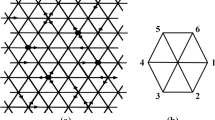Abstract
A cellular automata (CA) approach is proposed for simulating a fluid flow through porous materials with tortuous channels at pore level. The approach aims to combine CA methods both for constructing computer representation of porous material morphology and for simulating fluid flow through it. Morphology representation is obtained using CA whose evolution exhibits self-organization and results in a stable configuration. The latter is then used for Lattice Gas CA application to simulate fluid flow through a porous material specimen and compute its permeability properties. Special boundary conditions are introduced allowing for different smoothness of solid pore walls surface. The model has been tested on a small 2D fragment in a PC and then implemented to investigate a porous carbon electrode of a hydrogen fuel cell on 128 processors of a multiprocessor cluster.
Similar content being viewed by others
References
Sahimi M (1993) Flow phenomena in rocks: from continuum models to fractals, percolation, cellular automata and simulated annealing. Rev Mod Phys 65(4):1393–1533
Rothman BH, Zaleski S (1997) Lattice-gas cellular automata. Simple models of complex hydrodynamics. Cambridge Univ Press, London
Frish U, d’Humieres D, Hasslacher B, Lallemand P, Pomeau Y, Rivet JP (1987) Lattice-gas hydrodynamics in two and three dimensions. Complex Syst 1:649–707
Succi S (2001) The lattice Boltzmann equation for fluid dynamics and beyond. Oxford University Press, Oxford
Nabovati A, Sousa ACM (2007) Fluid flow simulation in random porous media at pore level using the lattice Boltzmann method. J Eng Sci Technol 2(3):226–237
Clague DS, Kandhai D, Zang R, Sloot PMA (2000) Hydraulic permeabolity of (un)bounded fibrous media using the lattice Boltzmann method. Phys Rev E 61(1):616–625
Pan C, Hilpert M, Miller CT (2001) Pore-scale modeling of saturated permeabilities in random sphere packings. Phys Rev E 64(6):006702
Bandman O (2005) Composing fine-grained parallel algorithms for spatial dynamics simulation. In: Malyshkin V (ed) LNCS, vol 3606. Springer, Berlin, pp 99–113
Chua L (2002) CNN: a paradigm for complexity. World Scientific, Singapore
Bandman O (2008) Mapping physical phenomena onto CA-models. In: Adamatsky A, Alonso-Sanz R, Lawiczak A, Martinez GJ, Morita K, Worsch Th (eds) AUTOMATA-2008. Theory and application of cellular automata. Luniver Press, UK, pp 391–397
Wolfram S (1984) Universality and complexity in cellular automata. Physica D 10:1–35
Achasova S, Bandman O, Markova V, Piskunov S (1994) Parallel substitution algorithm. Theory and application. World Scientific, Singapore
Toffolli T, Margolus N (1987) Cellular automata machines. MIT Press, Cambridge
Larminie J, Dicks A (2003) Fuel cells systems explained. Willey, New York
Medvedev YG (2003) Three dimensional cellular automata model of viscous fluid flow. Avtometriya 39(3):43–50. (In Russian)
Author information
Authors and Affiliations
Corresponding author
Rights and permissions
About this article
Cite this article
Bandman, O. Using cellular automata for porous media simulation. J Supercomput 57, 121–131 (2011). https://doi.org/10.1007/s11227-010-0391-5
Published:
Issue Date:
DOI: https://doi.org/10.1007/s11227-010-0391-5




